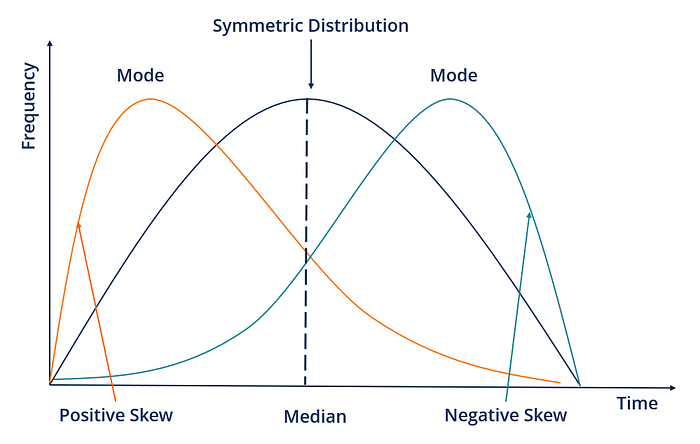

机器学习算法学习之特征工程3
电子说
描述
处理偏度和峰度
偏度和峰度是可以帮助理解数据分布的统计量。偏度度量数据的不对称程度,而峰度度量分布的峰度或平坦程度。

Fig.5 — Skewness
处理偏度的方法会对机器学习模型的性能产生负面影响。因此,处理数据中的偏度非常重要。以下是一些处理数据偏度的技巧:
1.对数变换(Log transformation):对数变换可以用来减少数据的偏度。它可以应用于正偏态和负偏态数据。
2.平方根变换(Square root transformation):平方根变换可以用于减少数据的偏度。它可以应用于正偏态数据。
3.Box-Cox变换(Box-Cox transformation):Box-Cox变换是一种更通用的变换方法,可以处理正偏态和负偏态数据。它使用参数lambda来确定要应用于数据的变换类型。
以下是一些Python代码演示这些变换技巧:
import numpy as np
import pandas as pd
from scipy import stats
# Generate some skewed data
data = np.random.gamma(1, 10, 1000)
# Calculate skewness and kurtosis
skewness = stats.skew(data)
kurtosis = stats.kurtosis(data)
print("Skewness:", skewness)
print("Kurtosis:", kurtosis)
# Log transformation
log_data = np.log(data)
log_skewness = stats.skew(log_data)
log_kurtosis = stats.kurtosis(log_data)
print("Log Skewness:", log_skewness)
print("Log Kurtosis:", log_kurtosis)
# Square root transformation
sqrt_data = np.sqrt(data)
sqrt_skewness = stats.skew(sqrt_data)
sqrt_kurtosis = stats.kurtosis(sqrt_data)
print("Sqrt Skewness:", sqrt_skewness)
print("Sqrt Kurtosis:", sqrt_kurtosis)
# Box-Cox transformation
box_cox_data, _ = stats.boxcox(data)
box_cox_skewness = stats.skew(box_cox_data)
box_cox_kurtosis = stats.kurtosis(box_cox_data)
print("Box-Cox Skewness:", box_cox_skewness)
print("Box-Cox Kurtosis:", box_cox_kurtosis)
处理峰度(kurtosis)的方法可以采用类似于处理偏度的变换方法。一些处理峰度的技巧包括:
1.对数变换:对数变换也可以用于处理数据中的峰度。
2.平方变换:平方变换也可以用于处理数据中的峰度。
3.Box-Cox变换:Box-Cox变换也可以用于处理数据中的峰度。
Fig.6 — Kurtosis
下面是一些 Python 代码来演示这些转换:
import numpy as np
import pandas as pd
from scipy import stats
# Generate some data with high kurtosis
data = np.random.normal(0, 5, 1000)**3
# Calculate skewness and kurtosis
skewness = stats.skew(data)
kurtosis = stats.kurtosis(data)
print("Skewness:", skewness)
print("Kurtosis:", kurtosis)
# Log transformation
log_data = np.log(data)
log_skewness = stats.skew(log_data)
log_kurtosis = stats.kurtosis(log_data
处理罕见类别
处理罕见类别是指处理在数据中出现不频繁的分类变量的过程。罕见类别可能会对机器学习模型造成问题,因为它们可能在数据中没有足够的代表性来准确地建模。一些处理罕见类别的技巧包括:
1.合并罕见类别:这涉及将罕见类别合并为单个类别或少数类别。这会减少变量中的类别数量,并增加罕见类别的代表性。
2.用更常见的类别替换罕见类别:这涉及用变量中最常见的类别替换罕见类别。如果罕见类别对分析不重要,这种方法可以很有效。
3.使用标志进行独热编码:这涉及为罕见类别创建一个新的类别,并将它们标记为罕见类别。这使得模型可以将罕见类别与其他类别区别对待。
以下是一个使用泰坦尼克号数据集处理罕见类别的示例:
import pandas as pd
import numpy as np
# load Titanic dataset
titanic = pd.read_csv('titanic.csv')
# view value counts of the 'Embarked' column
print(titanic['Embarked'].value_counts())
# group rare categories into a single category
titanic['Embarked'] = np.where(titanic['Embarked'].isin(['C', 'Q']), titanic['Embarked'], 'R')
# view value counts of the 'Embarked' column after grouping
print(titanic['Embarked'].value_counts())
# replace rare categories with the most common category
titanic['Embarked'] = np.where(titanic['Embarked'].isin(['C', 'Q']), titanic['Embarked'], 'S')
# view value counts of the 'Embarked' column after replacement
print(titanic['Embarked'].value_counts())
# create a new category for rare categories and flag them as rare
titanic['Embarked_R'] = np.where(titanic['Embarked'].isin(['C', 'Q']), 0, 1)
处理时间序列数据
处理时间序列数据涉及到多种技术,如数据预处理、特征提取和建模。让我们看一些技术以及如何使用Python实现它们。
Fig.7 — Time Series Data
1.数据预处理:时间序列数据通常包含缺失值、离群值和噪声数据,这些可能会影响模型的性能。因此,在训练模型之前进行数据预处理是必要的。一些常见的数据预处理技术包括填充缺失值、处理离群值和缩放。
2.特征提取:特征提取涉及从时间序列数据中提取有用的信息,以用于建模。一些流行的特征提取技术包括滚动统计、傅立叶变换和小波变换。
3.建模:一旦数据经过预处理并提取特征,就可以用于建模。一些流行的时间序列模型包括ARIMA(自回归综合移动平均)、LSTM(长短期记忆)和Prophet。
# Import libraries
import pandas as pd
import numpy as np
from sklearn.preprocessing import StandardScaler
from statsmodels.tsa.arima_model import ARIMA
from keras.models import Sequential
from keras.layers import LSTM, Dense
# Load time-series data
data = pd.read_csv('time_series_data.csv')
# Preprocess data
data.fillna(method='ffill', inplace=True)
data = data[(data['date'] > '2020-01-01') & (data['date'] < '2021-12-31')]
data.set_index('date', inplace=True)
scaler = StandardScaler()
data = scaler.fit_transform(data)
# Extract features
rolling_mean = data.rolling(window=7).mean()
fft = np.fft.fft(data)
wavelet = pywt.dwt(data, 'db1')
# Train ARIMA model
model = ARIMA(data, order=(1, 1, 1))
model_fit = model.fit(disp=0)
predictions = model_fit.predict(start='2022-01-01', end='2022-12-31')
# Train LSTM model
X_train, y_train = [], []
for i in range(7, len(data)):
X_train.append(data[i-7:i, 0])
y_train.append(data[i, 0])
X_train, y_train = np.array(X_train), np.array(y_train)
X_train = np.reshape(X_train, (X_train.shape[0], X_train.shape[1], 1))
# Define the LSTM model
model = Sequential()
model.add(LSTM(units=50, return_sequences=True, input_shape=(X_train.shape[1], 1)))
model.add(Dropout(0.2))
model.add(LSTM(units=50, return_sequences=True))
model.add(Dropout(0.2))
model.add(LSTM(units=50))
model.add(Dropout(0.2))
model.add(Dense(units=1))
# Compile the model
model.compile(optimizer='adam', loss='mean_squared_error')
# Fit the model to the training data
model.fit(X_train, y_train, epochs=100, batch_size=32)
**文本预处理 **
文本预处理是处理文本数据时特征工程的一个关键步骤。其目标是将原始文本转换为可用于机器学习模型的数字表示。以下是Python中常用的一些文本预处理技术:
分词:将句子或文档分解为单个单词或短语。NLTK库提供了各种分词器,例如单词分词器和句子分词器。
from nltk.tokenize import word_tokenize, sent_tokenize
text = "This is a sample sentence. It contains some words."
words = word_tokenize(text)
sentences = sent_tokenize(text)
print(words)
# Output: ['This', 'is', 'a', 'sample', 'sentence', '.', 'It', 'contains', 'some', 'words', '.']
print(sentences)
# Output: ['This is a sample sentence.', 'It contains some words.']
2.停用词去除:停用词是一些常见的不添加任何文本含义的单词,例如“a”、“the”、“and”等。去除停用词可以提高文本处理的效率并减小数据的大小。NLTK库为各种语言提供了一个停用词列表。
from nltk.corpus import stopwords
stop_words = set(stopwords.words('english'))
filtered_words = [word for word in words if word.casefold() not in stop_words]
print(filtered_words)
# Output: ['sample', 'sentence', '.', 'contains', 'words', '.']
Fig.8 — Text Processing
3.词干提取和词形还原:词干提取和词形还原是将单词缩减为其基本或根形式的技术。例如,“running”、“runner”和“runs”可以缩减为根词“run”。NLTK库提供了各种词干提取器和词形还原器。
from nltk.stem import PorterStemmer, WordNetLemmatizer
stemmer = PorterStemmer()
lemmatizer = WordNetLemmatizer()
stemmed_words = [stemmer.stem(word) for word in filtered_words]
lemmatized_words = [lemmatizer.lemmatize(word) for word in filtered_words]
print(stemmed_words)
# Output: ['sampl', 'sentenc', '.', 'contain', 'word', '.']
print(lemmatized_words)
# Output: ['sample', 'sentence', '.', 'contains', 'word', '.']
4.文本规范化:文本规范化涉及将文本转换为标准化形式,例如将所有文本转换为小写,去除标点符号,并用它们的全称替换缩写和缩略语。
import re
def normalize_text(text):
text = text.lower()
text = re.sub(r'[^\\w\\s]', '', text)
text = re.sub(r'\\b(can\\'t|won\\'t|shouldn\\'t)\\b', 'not', text)
text = re.sub(r'\\b(i\\'m|you\\'re|he\\'s|she\\'s|it\\'s|we\\'re|they\\'re)\\b', 'be', text)
return text
text = "I can't believe it's not butter!"
normalized_text = normalize_text(text)
print(normalized_text)
# Output: 'i not believe be not butter'
总结
总之,特征工程是机器学习过程中的关键步骤,涉及将原始数据转换为机器学习算法可以有效使用的格式。在本篇博客文章中,我们介绍了各种特征工程技术,包括特征选择和提取、编码分类变量、缩放和归一化、创建新特征、处理不平衡数据、处理偏斜和峰度、处理稀有类别、处理时间序列数据、特征转换和文本预处理。
以下是本文的主要要点:
1.特征选择和提取可以使用统计方法,如PCA、LDA和相关性分析,以及机器学习方法,如基于树的方法、包装方法和嵌入式方法。
2.编码分类变量可以使用诸如独热编码、标签编码和计数编码等技术。
3.缩放和归一化可以使用诸如最小-最大缩放、标准缩放和鲁棒缩放等技术。
4.文本预处理涉及技术,如分词、停用词去除、词干提取和词形还原。
-
机器学习算法汇总 机器学习算法分类 机器学习算法模型2023-08-17 1923
-
机器学习的经典算法与应用2023-05-28 2076
-
机器学习算法学习之特征工程12023-04-19 1551
-
有感FOC算法学习与实现总结2021-07-05 2768
-
SVPWM的原理与算法学习课件免费下载2021-03-08 1194
-
机器学习算法的特征工程与意义详解2020-10-08 3355
-
模拟退火的算法学习2020-06-16 1419
-
机器学习特征工程的五个方面优点2020-03-15 4472
-
贪心算法学习2019-09-04 3965
-
机器算法学习比较2016-09-27 4956
全部0条评论

快来发表一下你的评论吧 !

